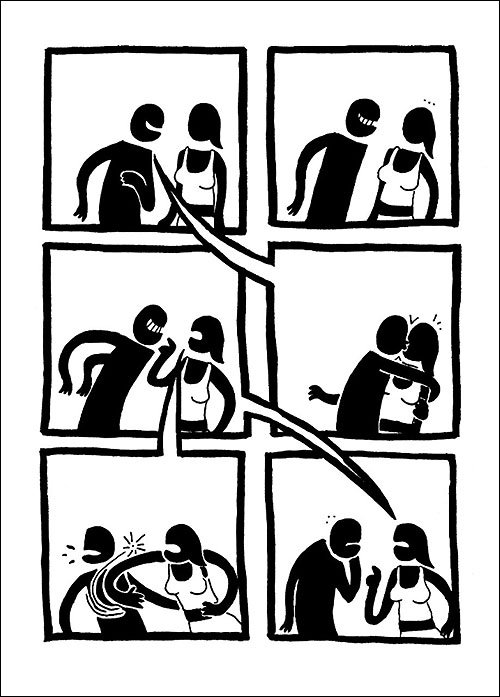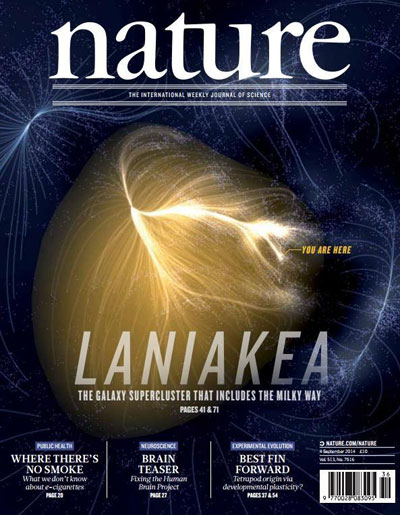
(source)
Passing on interesting knowledge is one of the best legacies we can leave the next generation. Here follows an incomplete list of the ideas and facts that have most fascinated, astounded, or influenced me. Please enjoy them, share with children, and consider publishing your own list.
Watch videos of magic tricks revealed with your kids.
First watch the normal performance of the magic trick with your kids,
then pause the video before the mechanics of the trick are revealed
and ask your kids how they think the trick might be performed.
Each of you can propose a hypothesis.
Then continue the video to see how it was actually done.
This is a great exercise for promoting critical thinking.
video search: magic tricks revealed
video: Dynamo coin through table revealed
Encourage your kids to ask questions, and to develop their own hypotheses to answer questions, and them show them how to find out answers. For example, why do some plants produce flowers, and why do some plants produce fruits? Ask your kids to come up with a hypothesis to answer these questions. Show them how they can then perform research (for example, by using an online search engine) to find answers.
Mix up some "oobleck" in your kitchen and play with it with your children.
Oobleck is a mixture of cornstarch and water
(1 part of water with 1.5-2 parts of cornstarch).
Oobleck is a non-newtonian fluid that can pour like a liquid,
but if struck rapidly it reacts like a solid.
It is possible to walk over a tub filled with oobleck if you walk quickly enough.
Oobleck also reacts very strangely when placed on top of a vibrating surface like
a speaker.
http://www.youtube.com/watch?v=RUMX_b_m3Js
http://www.youtube.com/watch?v=3zoTKXXNQIU
http://www.youtube.com/watch?v=RkLn2gR7SyE

Every morning, ask your children if they can remember their dreams.
Tell them about lucid dreams:
dreams where the dreamer knows that he or she is dreaming,
and can sometimes take control of the dream.
There are techniques to help yourself become lucid,
that you or your children may be interested in trying.
http://www.youtube.com/watch?v=5g3YBXyvXSo
http://www.youtube.com/watch?v=lYSX51xBkos
http://www.youtube.com/watch?v=rrFb9ihPSb0
http://www.brainpickings.org/2012/10/12/the-science-of-lucid-dreaming/
If you like the topic of lucid dreams, you might enjoy the movie "Waking Life".
buy: Waking Life DVD
Challenge your kids to learn how to use a yo-yo, play cat's cradle, throw and catch a frisbee and a boomerang, do cartwheels, blow bubble gum, shuffle a deck of cards, jump rope, juggle balls, learn to swim, braid hair (or, if long hair is not available, braid shoelaces), tie a tie, walk on stilts, and ride a unicycle. If you don't know how to do these things yourself, try learning with your kids.
Have your kid try out a simple programming environment, such as Scratch (which is free and runs within a web browser, requiring no software installation).
Have your kids try Minecraft the video game.
Better yet, try playing it with them in a shared world over a network.
It's the most fun I've ever had with my kids involving a video game,
and can be highly creative, educational, and cooperative.
https://minecraft.net
Enroll your kid in music lessons, if you can afford it. Brain scans show that performing music stimulates multiple brain areas like no other activity.
http://www.youtube.com/watch?v=R0JKCYZ8hng
If you can afford the trip, it's wonderful for children (and adults) to see the Smithsonian museums in Washington, DC. My favorite is the Smithsonian Natural History Museum.
If you're comfortable with math, show your child how estimation and approximation can be used to answer interesting questions. For example, how many babies are born every second? We can figure this out simply knowing the population of the world (about 7.5 billion) and making a guess of the average life span of humans (say 50 years). Assuming that the earth's population remains the same over time (which is a good approximation over a time scale of a few seconds), imagine that all 7.5 billion people on the earth are born at the same time and age together until they reach their maximum age (50 years) and then they all die simulateously and are replaced by 7.5 billion new babies. The average birth rate, then, would be 7.5 billion babies per 50 years, which is the same rate that we would work out if we imagined all these people being born at different times. 7.5 billion divided by 50 years gives us 150 million per year = 411000 per day = 17000 per hour = 4.8 babies born per second. Now, to check my math, I perform a google search on the phrase "how many babies are born in a second", and the answer "4.3 births every second" comes up. Not bad. Another much simpler math problem for a young kid to try to solve is this: how fast must a car travel, in kilometers per hour (or in miles per hour), to travel one kilometer per second (or one mile per second)?
A Rattleback is a passive, rigid physical object
that prefers to spin in one direction and not the other.
Buy one of these to show your kids.
I also recommend buying your kids a prism (to show them how to make a rainbow),
some magnets (so they can feel the attraction and repulsion of north and south magnetic poles),
a gyroscope (to demonstrate precession),
and a LEGO technic set of a car with rack-and-pinion steering and a differential so they can see how these things work.
buy: Rattleback
 (source)
(source)
 (source)
(source)
 (source)
(source)
For a bit more money, you can buy your child a double pendulum to demonstrate sensitivity to initial
conditions.
You could also buy some "solids of constant width"
https://www.youtube.com/watch?v=AoueExyXkWY which are related to the Reuleaux triangle.
A much more expensive toy, but quite interesting for the mathematical story behind it,
is the Gömböc
video search: Gomboc
http://gomboc-shop.com/
Look up and construct the "African String Puzzle" for your kids. A simple version can be made with cardboard, string, and scissors. Challenge your kids to solve it.
Play games with your children, such as strategy games and board games. I recommend starting with games that are easy to learn, and that the adults are not overly familiar with, to give your child more of a chance. For example, you might try Chopsticks (played only using fingers), Dots and Boxes (played with paper and pencil), Sprouts (played with paper and pencil), Quixo (which you can construct yourself out of cardboard if you like), Mastermind, Jungle Chess, also known as Dou Shou Qi, or Connect Four, also known as Captain's Mistress. (See also German-style board games). Apples to Apples is a simple game for developing analogical thinking and persuasive argumentation. Charades or the similar game Guesstures is fun for acting out words and concepts. Once Upon a Time is a simple card game for developing story telling and story creation skills. Consider trying different kinds of games with your child, involving strategy, the body, hand-eye coordination, different kinds of creativity, competition, and cooperation. Different children will enjoy different kinds of games (see Theory of multiple intelligences and Learning styles ).
If your child really likes strategy games, consider playing Go with them (also called Weiqi or Baduk), which has very simple rules but can be studied for years. Go involves a lot of intuition, and demonstrates a clear combination of both tactics (low-level details of localized conflicts) and strategy (high-level, longer term planning over the whole board), with many aspects of play being analogous to a battle (attacking, defending, surrounding, cutting off, escaping, invading). Personally, I found that the learning curve for Go was smoother than for chess. Many parents teach their children to play chess, but consider playing Chinese chess (xiang qi) with your children instead. Chinese chess has rules that are similar to chess, but the opening of the game is open to many more possibilities, and teaches children to keep track of many pieces simultaneously, whereas the pieces in western chess are very congested at the beginning of a game. If you don't already know Chinese chess, you can have fun learning it at the same time as your child, making gameplay more even and interesting for both of you.
If you're really interested in chess, the ultimate book on variants of chess (cataloging more than 1000 of them) is David Pritchard's "The Classified Encyclopedia of Chess Variants", which can be downloaded for free from https://www.jsbeasley.co.uk/encyc.htm
David Macaulay has (co-)written "The Way Things Work" (1988), "The New Way Things Work" (1988), "The Way Things Work Now" (2016), which all contain entertaining illustrations of the functioning of myriad machines, from simple mechanical devices to digital circuits. I personally prefer the 1988 edition, because it shows (among many other things) how to construct a 'half adder' and 'full adder' using transistors, showing how arithmetic can be done with a digital circuit.
Wilson and Burnie's book "Animal: The Definitive Visual Guide to the World's Wildlife" is the most complete catalog of animal species I know of.
My playlist of the most interesting videos I've found on youtube: https://www.youtube.com/playlist?list=PLWDaTqG3UM0OYIKeb2CR9GZ6pgdIZVI1v
I highly recommend viewing the 2014 video series Cosmos: A Spacetime Odyssey presented by Neil deGrasse Tyson,
which is an updated version of the 1980 series Cosmos: A Personal Voyage presented by Carl Sagan.
Every child should see at least one of these series.
They present the history of the universe and the earth,
the majesty of the universe,
and some wonderful lessons about the history of science.
video search: Cosmos Neil deGrasse Tyson
video search: Cosmos Carl Sagan
buy: Cosmos Neil deGrasse Tyson DVD
buy: Cosmos Carl Sagan DVD
I also recommend David Attenborough's nature documentaries (my favorites are "Life in the Undergrowth" and "First Life: Conquest").
video search: David Attenborough
buy: David Attenborough DVD
I found Neil Shubin's "Your Inner Fish" video documentary quite good too, for showing evidence of evolution.
Fiction I enjoyed watching with my kids:
"Stardust" (2007 comedy fantasy film co-starring Michelle Pfeiffer and based on a book by Neil Gaiman);
"Contact" (1997 sci-fi film starring Jodie Foster and based on Carl Sagan's book);
"Arrival" (2017 sci-fi film directed by Denis Villeneuve);
Jim Henson's "The Storyteller" (a TV series available on DVD),
especially the episode "The Soldier and Death";
and episodes of "The Twilight Zone" TV series,
especially "A Small Talent for War" and "I of Newton" with their delicious twist endings.
video search: Storyteller Soldier Death
video search: Twilight Zone A Small Talent for War
video search: Twilight Zone I of Newton
The following are also excellent, but contain more violence:
"Dune" (1984 sci-fi film directed by David Lynch);
"Memento" (2000 film whose story is told backwards to give the audience the point of view of someone with anterograde amnesia);
"Primer" (2004 sci-fi film made with a very small budget but presenting a very clever story about time travel).
This is the greatest comic strip I've ever seen. It was created by Ibn Al Rabin. The cleverness of it astounds me. First read the six panels in sequence, like a story. Then carefully study the arrows of the "talk bubbles".

YouTube channels: Vsauce with Michael Stevens, Vintage Space with Amy Shira Teitel, Vi Hart with Victoria Hart, Veritasium with Derek Muller, Two Minute Papers with Károly Zsolnai-Fehér, The Slow Mo Guys , TheBadAstronomer with Phil Plait, thang010146 with Nguyen Duc Thang, TED-Ed , Stated Clearly with Jon Perry, Socratica , Smithsonian , SmarterEveryDay with Destin Sandlin, Sixty Symbols with Brady John Haran, Seeker Daily , SciShow , Scientific American , Royal Institution of Australia , Royal Institution , Quanta Magazine , QualiaSoup , Physics Girl with Dianna Cowern, Periodic Videos , PBS Space Time with Matthew O'Dowd, PBS Infinite Series with Kelsey Houston-Edwards, Numberphile with Brady John Haran, Nature Video , NASA , MinutePhysics with Henry Reich, Mathologer , Kurz Gesagt - In a Nutshell , Jeri Ellsworth , It's Okay To Be Smart , iBiology , Grand Illusions with Tim Rowett, gilbondfac , fuck yeah fluid dynamics , EngineerGuy with Bill Hammack, DNews , Deep Look , CrashCourse , Closer To Truth with Robert Lawrence Kuhn, CGP Grey, brusspup , Big Think , AsapSCIENCE, 3Blue1Brown with Grant Sanderson
Closer To Truth, especially this interview with David Deutsch
http://edge.org - check out their annual question and the answers to it
Aeon Magazine , Big Think , Nautilus Magazine , Quanta Magazine , Quora , Scientific American , TED , Wikipedia
Coursera , Khan Academy , World Science U , Brilliant
Genes are converted to proteins through a 2-stage process of transcription and translation, which is referred to as the Central dogma of molecular biology (a misuse of the term "dogma" by Francis Crick that stuck). Genes (made up of sequences of the nucleotides A, C, G, and T) are first transcribed into messenger RNA (mRNA) molecules (made up of sequences of the nucleotides A, C, G, and U), which are then translated into sequences of amino acids called proteins. The term "genetic code" refers to the mapping of nucleotide triplet codons to amino acids. For example, the sequence ACG is mapped to the amino acid Threonine. Various tables and diagrams show the complete mapping (image search: genetic code). This mapping is determined by transfer RNA (tRNA) molecules, that have an anticodon on one end and an amino acid on the other end. Significantly, it seems that this mapping is arbitrary, and that a different mapping (with different tRNA molecules) would have been possible. However, because all known living things have the same (arbitrary) genetic code, this indicates that all living things descended from a single common ancestor. Pick a random vegetable, and rest assured, you and it are cousins: you share a common ancestor. All living things on the earth are one family.
video: David Bolinsky: Visualizing the wonder of a living cell
videos: Inner Life of the Cell, by Harvard University
DNA is coiled at multiple levels:
http://apod.nasa.gov/apod/ap120821.html
https://www.youtube.com/watch?v=OjPcT1uUZiE
Wired: Absurd Creature of the Week
There's a group (technically a phylum) of animals called the arthropods that accounts for something like 80% or more of all living animal species. The arthropods include the insects, crustaceans, arachnids (which includes spiders, scorpions, ticks, and mites), millipedes and centipedes, as well as extinct creatures such as the trilobites and eurypterids. Arthropods were among the first animals to emerge onto land, and the first ones to achieve flight. Some of them grew impressively large. Eurypterids and prehistoric millipedes (Arthropleura) could reach a length of more than 2 meters, while prehistoric dragonflies (Meganeura) could grow to wingspans of up to 65 cm (25.6 inches).
The Burgess Shale,
located in British Columbia,
has revealed an enormous variety of fossils of ancient animals found nowhere else,
including many strange arthropods and related creatures.
Opabinia had 5 eyes and a mouth at the end of a flexible appendage.
Anomalocaris could reach lengths of up to 2 meters.
Hallucinogenia was first thought to walk on long, skinny legs,
but later biologists decided they had been looking at the fossil upside down, and that the spikes were probably on its back.
See also Marrella.
Fossils of the Burgess Shale
The horseshoe crab is perhaps the most primitive arthropod alive - an animal with blue blood, book gills, some of its eyes on its tail, a mouth at the center of its legs, and the largest rods and cones of any animal!
You may have occasionally seen woodlice (also called pill bugs, roly-polies, sow bugs) in your garden. These critters are not insects. They have 14 legs, and are actually terrestrial crustaceans! Even more interesting, there's a closely related, much larger but very similar looking animal called the giant isopod that lives in the deep ocean!
Velvet worms (Onychophora) are not arthropods; they have soft bodies, and look like worms with legs. They're a sort of evolutionary intermediate between annelids (segmented worms like earthworms and leeches) and arthropods. Interestingly, they capture prey by spitting glue out onto them!
C. elegans
is a roundworm that is the subject of much scientific study.
It is distinguished by being the simplest animal to exhibit sleep-like states,
as well as the simplest to exhibit aging.
Its body comprises approximately 1000 cells, including about 300 neurons,
which are sufficient for finding food and mates and avoiding predators.
It can survive freezing and desiccation, making it easy to store in a lab.
It was the first multicellular organism to have its complete genome sequenced.
It is, so far (at the time of writing in 2014), the only organism to have had its
connectome (complete neuronal connections) mapped.
It is also the only organism to have had its complete cell lineage mapped,
showing how its cells develop and specialize from zygote onward.
Furthermore, researchers have developed a means to perform functional imaging of individual
neurons in the worm, to see neuronal activity as it occurs.
An open-science, crowd-funded
project called OpenWorm is attempting to develop a detailed software simulation of C. elegans' entire body.
And finally,
when a C. elegans worm dies,
a phenomenon called "death fluorescence" makes it emit a transient blue light.
video: Blue death: The frontiers of ageing research (see 3:00)
John Sulston
image search: c elegans cell lineage
article search: Prevedel "Simultaneous whole-animal" "neuronal activity"
http://dx.doi.org/10.1038/nmeth.2964
http://www.nature.com/nmeth/journal/v11/n7/full/nmeth.2964.html
The nautilus has a detachable penis
that swims through water to the female!
video: Carin Bondar: The birds and the bees are just the beginning (see 1:20)
video: Carin Bondar: The birds and the bees are just the beginning (see 1:20)
Hectocotylus
The mantis shrimp
has the most advanced visual system in the world.
Humans have 3 kinds of cone cells (color-receptor cells),
which is why 3 primary colors suffice to mix and create any visible color for humans.
However, the mantis shrimp has
12 kinds of cones (implying that it is vastly more sensitive to subtle differences in color that are completely
invisible to humans);
each of its two eyes are mounted on an independently moving stalk;
it can perceive ultraviolet light;
and it has trinocular depth vision in each eye
(whereas humans only have binocular depth vision as a result of both eyes working together).
Furthermore, its claws are so fast and strong
that they produce cavitation bubbles and sonoluminescence.
http://arthropoda.wordpress.com/category/arthropods/crustaceans/stomatopods-mantis-shrimp/
video: True Facts About The Mantis Shrimp
video


Other amazing invertebrates:
Tardigrade
Velella (video: Plankton Chronicles- Velella)
Nudibranch and Glaucus atlanticus

Most marsupials have a bifurcated penis in the males and two vaginas in the females!
And humans are sometimes born with two vaginas or two penises:
search: Hazel Jones vaginas
search: diphallic dude

Kangaroos can kick with both legs simultaneously by balancing on their tale: http://www.youtube.com/watch?v=rRddLDynsCs&t=1m20s
Wolves can change the course of rivers:
http://www.youtube.com/watch?v=8a3r-cG8Wic
http://vimeo.com/86466357
Trophic cascade
The curliness of human hair is related to the shape of the hair's cross-section.
I was surprised to learn this while skimming an article presented at SIGGRAPH
(the world's top computer graphics conference)
that was co-authored by researchers at L'Oréal!
Quoting the article:
"Africans have follicles with a helical form
and an oval cross section, whereas Asians have follicles that are
completely straight with a larger and circular cross section.
As a result, Asian hair is thicker, with no natural curliness.
It makes it look smooth and regular.
In contrast, African hair looks frizzy and irregular.
Caucasian hair stands between these two extremes."
article search: Bertails "Super-Helices for Predicting the Dynamics of Natural Hair"
video for the article
You may have heard that the human tongue senses sweet, salty, sour, and bitter tastes. Have you heard of the "fifth" taste, umami?
How did humans become so intelligent, far beyond other animals? Some of the key factors seem to be that (1) humans are social animals, and sometimes need to imagine what the world is like from the point of view of other individuals (for example, when trying to deceive others), and (2) our vocal cords can produce many different sounds, enabling us to develop spoken language.
Another factor which may have contributed is related to the following tradeoff.
Due to limits on the number of calories that can be consumed in one day, there seems to be a
tradeoff between body size and number of neurons in primates.
However, the ancestors of humans appear to have escaped this tradeoff by discovering fire and inventing cooking,
allowing food to be digested much more easily.
video: Suzana Herculano-Houzel: What is so special about the human brain? (see 8:05-11:30)
video: Suzana Herculano-Houzel: What is so special about the human brain? (see 8:05-11:30)
Additional tradeoffs seem to exist with relation to our brain and suggest
that our brain may be nearly optimal for the kind of tissue it is build from.
Douglas Fox wrote about this in the July 2011 issue of Scientific American, in an article entitled "The Limits of Intelligence".
For example, increasing the number of neurons would increase brain size, making connections longer and therefore slower,
as well as costing more energy.
Adding more interconnections, or making these interconnections thicker (and therefore faster),
would also increase energy consumption and take up more space.
And making neurons or connections smaller would increase random firing and therefore noise.
illustration from article by Douglas Fox: "Why We Probably Cannot Get Much Smarter"
Steven Pinker thinks that three things co-evolved to make humans
unique: we're very social, we have spoken language,
and we have technology.
Steven Pinker -- On psychology and human nature
Jerry Coyne's book "Why Evolution is True" surveys the overwhelming evidence for biological evolution,
covering many examples from transitional forms in fossils,
historical traces in genomes,
vestigial organs and other examples of poor design in our bodies,
comparative anatomy,
embryology,
and biogeography (analyzing the kinds of species found on islands).
video: 'Why Evolution Is True' by Jerry Coyne, AAI 2009
video: Evolution: It's a Thing - Crash Course Biology #20
Stated Clearly: What is the Evidence for Evolution? https://www.youtube.com/watch?v=lIEoO5KdPvg&t=54s
Creationists sometimes claim that the theory of evolution makes no predictions, and is therefore not a scientific theory. In fact, the theory of evolution has made predictions about where to find certain fossils, by basically saying that fossils of intermediate form between fossil A and fossil B could be found in exposed rocks of an age that is intermediate between the ages of A and B. For example, Neil Shubin predicted that an intermediate form between fish and amphibians could be found in exposed rocks in the Canadian arctic, leading to the discovery of Tiktaalik. Another example I'll simply quote from http://www.darwinwasright.org/distribution_examples.html : "The earliest marsupial fossils are about 80 million years old and found in North America; by 40 million years ago fossils show that they could be found throughout South America, but there is no evidence of them in Australia, where they now predominate, until about 30 million years ago. The theory of evolution predicts that the Australian marsupials must be descended from the older ones found in the Americas. The theory of continental drift says that between 30 and 40 million years ago South America and Australia were still part of the Southern hemisphere super continent of Gondwana and that they were connected by land that is now part of Antarctica. Therefore combining the two theories scientists predicted that marsupials migrated from what is now South America across what is now Antarctica to what is now Australia between 40 and 30 million years ago. This hypothesis led paleontologists to Antarctica to look for marsupial fossils of the appropriate age. After years of searching they found, starting in 1982, fossils on Seymour Island off the coast of the Antarctic Peninsula of more than a dozen marsupial species that lived 35-40 million years ago."
It used to be a mystery how an eye could evolve, because of the many components required.
But we now have an explanation that only involves small incremental changes,
with the acuity of the eye increasing with each step:
Evolution of the eye
Genetic sequencing published in 2004 has profoundly confirmed that humans evolved from earlier primates,
by showing that one of our human chromosomes was the result of the fusion of two primate chromosomes.
Chapter 1 of the Dan Fairbanks' book "Relics of Eden", written by a Christian and geneticist, discusses this in detail,
showing the precise nucleotide sequence surrounding the chromosomal fusion point, and why it is unmistakably the result of
a fusing of earlier chromosomes.
video: The Collapse of Intelligent Design:Kenneth R. Miller Lecture (presentation by a Christian) (see 35:45)
article search: hillier 2004 "generation and annotation of the DNA"
According to a 2009 survey, 97% of scientists "say humans and other living things have evolved over time".
http://ncse.com/blog/2013/08/how-many-creationists-science-0014996
http://ncse.com/news/2009/07/views-evolution-among-public-scientists-004904
http://www.people-press.org/2009/07/09/section-5-evolution-climate-change-and-other-issues/
http://en.wikipedia.org/wiki/Level_of_support_for_evolution
Examples of poor design and vestigial features of our anatomy include the recurrent laryngeal nerve (which follows a needlessly long detour in humans, and an even longer one in giraffes), lanugo (a useless coating of hair covering a human fetus that is shed before birth), and the yolk sac in human fetal development that contains no yolk but for which we have identified the gene responsible and found it to be a modified version of the corresponding gene in reptiles and birds. These phenomena are easily explained in the context of evolution, but make little or no sense within a creationist context.
Video: Richard Dawkins demonstrates laryngeal nerve of the giraffe
As an example of comparative anatomy providing evidence for evolution,
consider how the bones in whale limbs match up in number and arrangement
to those of land dwelling vertebrates, and look nothing like the bones in fish fins.
This makes sense if whales descended from land dwelling animals,
but not if whales and fish were created by a common designer.
The evolution of whales

Evolution is also witnessed in the way viruses rapidly mutate and adapt, and in the large variety of human-created breeds of dogs, cats, farm animals, and farm crops (example: http://www.vox.com/2014/10/15/6982053/selective-breeding-farming-evolution-corn-watermelon-peaches). Evolution also explains how cancer cells inevitably appear within a human who lives long enough (see George Johnson's January 4, 2014 article Why Everyone Seems to Have Cancer).
The theory of evolution does not explain how life originated; only how it diversified once it started. Abiogenesis, the origin of life from non-life, is still a big unsolved problem in biology, although the "RNA World" hypothesis offers a sketch of a solution.
Stated Clearly: Can Science Explain the Origin of Life? https://www.youtube.com/watch?v=fgQLyqWaCbA&t=2m29s
video: What Is the RNA World Hypothesis? (2:28-5:43)
video: What is Chemical Evolution? (4:37-6:55)
article search: ricardo szostak "origin of life on earth"
article search: pressman blanco chen rna world model system study origin life
article search: wolf koonin origin translation system genetic code rna world natural selection exaptation subfunctionalization
https://scholar.google.ca/scholar?q=horning+joyce+amplification+rna+polymerase+ribozyme
video: Jack Szostak (Harvard/HHMI) Part 1: The Origin of Cellular Life on Earth
Video showing a model simulation of a self-assembling virus.
Most dangerous and deadly substances:
http://www.youtube.com/watch?v=ckSoDW2-wrc
http://www.youtube.com/watch?v=2z35_1e1MtI
I recommend learning how a car differential works,
preferably with a physical model in your hands such as LEGO bricks.
It's an extremely clever and elegant mechanical device for distributing power to wheels
when one wheel is unable to turn as quickly as the other.
For example, when a car is making a turn, the inner wheel cannot rotate as quickly
as the outer wheel without slipping, thus having the wheels connected
with a rigid axle would cause slipping, however a differential allows
the two wheels to rotate at different rates during a turn.
video search: car differential
video search: car differential lego
 (source)
(source)
Another very clever mechanical device worth seeing at least once
is the "action" of a piano.
video search: piano action
wikipedia: Linkage_(mechanical)
https://en.wikipedia.org/wiki/Burmester's_theory
video: Albert Michelson’s Harmonic Analyzer
A Rattleback is a passive, rigid physical object
that prefers to spin in one direction and not the other.
http://www.youtube.com/watch?v=69Xm762qE8o
Chains of dominos:
http://www.youtube.com/watch?v=y97rBdSYbkg
http://www.youtube.com/watch?v=8yYWILv91YU&t=2m57s
A parabola can be defined as the curve of intersection between a cone and a plane that is parallel to the axis of the cone
(conic section).
Parabolic reflectors have the property that incoming parallel rays are all reflected onto a single focal point.
This is useful in radio antennae directed toward a satellite and microphones that can pick up sounds from far away.
Parabolic reflectors are also used for reflecting all of the emitted rays from a source toward some direction.
http://www.youtube.com/watch?v=UQrKtiKfmMU
Retroreflectors, commonly used on bicycles, are made up of tiny facets that reflect incoming rays back toward the source. The driver of an automobile is thus likely to see light from their headlights reflected back at them.
 (source)
(source)
 (source)
(source)
granular convection
video search: granular convection
http://www.youtube.com/watch?v=c3p3VMNpWGw
http://www.youtube.com/watch?v=HKvc5yDhy_4
http://www.simonsfoundation.org/multimedia/mathematical-impressions-multimedia/mathematical-impressions-spontaneous-stratification/
http://space.io9.com/spontaneous-stratification-of-sand-and-sugar-1588400779
Phase changes demonstrated in a granular material: video: A simple demonstration of granular phases
When poured, liquids sometimes coil like a rope, depending on factors such as their viscosity.
This is described in the February 2014 issue of Scientific American.
http://www.scientificamerican.com/article/dribbling-fluids-coil-around-like-ropes/
http://www.scientificamerican.com/article/coils-do-it-yourself-coiling-liquids/
http://www.nature.com/scientificamerican/journal/v310/n2/full/scientificamerican0214-66.html

Viscous liquid on moving belt: http://www.youtube.com/watch?v=CMYISqxS3K4
Superhydrophobic metal surface etched with lasers makes water bounce off of it:
http://www.youtube.com/watch?v=7nD7gr1NIf4
http://www.youtube.com/watch?v=FLegmQ8_dHg
Leidenfrost effect: http://www.youtube.com/watch?v=vPZ7sx3EwUY
Music video featuring multiple unusual physics phenomena:
"CYMATICS: Science Vs. Music" by Nigel Stanford
http://vimeo.com/111593305
http://nigelstanford.com/Cymatics/
http://thekidshouldseethis.com/post/cymatics-science-music-audio-frequency-visualizations
http://en.wikipedia.org/wiki/Ernst_Chladni
http://www.youtube.com/watch?v=2awbKQ2DLRE
How to derive Einstein's special relativity:
http://www.youtube.com/watch?v=Mpw68rvF4pc
http://www.businessinsider.com/physics-science-time-travel-back-to-the-future-2015-1
Changes in frame of reference cause electric and magnetic forces to transform into each other, courtesy of Einstein's special relativity.
So, it seems like magnetism is a sort of illusion.
video: Veritasium: How Special Relativity Makes Magnets Work
video: MinutePhysics: MAGNETS: How Do They Work?
http://physics.weber.edu/schroeder/mrr/mrr.html
http://physics.weber.edu/schroeder/mrr/MRRtalk.html
Leonard Susskind's course on particle physics: https://www.youtube.com/playlist?list=PLF363FFF951EC0673
The Copenhagen interpretation of quantum physics is only one of many. For example, the Bohm interpretation is deterministic, involves real wavefunctions, but also involves hidden variables, all in opposition to the Copenhagen interpretation. Here's a table comparing the alternatives: http://en.wikipedia.org/wiki/Interpretations_of_quantum_mechanics#Comparison_of_interpretations
Where does rain get its smell?
http://www.youtube.com/watch?v=Waqmq_GTyjA
Levitating magnet: http://www.youtube.com/watch?v=hri1IsxKw3E
wikipedia: Bekenstein bound
https://en.wikipedia.org/wiki/Bremermann's_limit
69536 x 22230 pixel photo of Andromeda galaxy, created in January 2015:
http://www.youtube.com/watch?v=udAL48P5NJU
http://www.spacetelescope.org/images/heic1502a/
The Laniakea supercluster of galaxies: http://www.youtube.com/watch?v=rENyyRwxpHo

Dennis Overbye's video series "Out There" at the New York Times: http://www.nytimes.com/video/out-there/
Two books that I cannot recommend highly enough are Roger Penrose's The Emperor's New Mind, and Douglas Hofstadter's Gödel, Escher, Bach. They were, by far, the most enriching two books I ever read.
Penrose's book The Emperor's New Mind argues that the human brain may exploit certain (as yet poorly understood) quantum phenomena that in effect make its functioning uncomputable. More precisely, Penrose shows why it may be the case that classical computers cannot simulate a brain (there is no reason, however, why quantum computers would not be able to simulate a brain). Although you may not agree with Penrose's conclusion, the tour of physics, mathematics, and computer science that he takes the reader through makes the book well worth reading. For example, it contains a chapter with a highly readable description of Turing Machines, Universal Turing Machines, and the halting problem, and raises many interesting questions.
Hofstadter's book Gödel, Escher, Bach adopts the position that there is no compelling reason why computers will not be able to eventually simulate human intelligence. This book touches on many fascinating topics, including Zen, metamathematics, strange loops, music and word play. It includes an explanation and informal (but convincing) proof of Gödel's incompleteness theorem. The proof, once understood, will give you such an "AHA!" experience of insight that it alone makes the time invested reading this book more than worthwhile.
For a much shorter text about some of Hofstadter's (and his
students') ideas about how human intelligence works,
refer to the highly readable and highly cited paper
http://scholar.google.ca/scholar?q=chalmers+french+hofstadter+%22High-level+perception%2C+representation%2C+and+analogy%3A+A+critique+of+artificial+intelligence+methodology%22
Chris Eliasmith and his team have constructed the largest functional model of a brain to date,
with 2.5 million spiking neurons, able to perform multiple tasks including recognizing symbols,
completing sequences, and controlling an arm to write output.
video: Chris Eliasmith on "How to Build a Brain"
http://nengo.ca/build-a-brain/spaunvideos
article search: Eliasmith "A large-scale model of the functioning brain"
article search: Eliasmith "use and abuse of large-scale brain models"
Impressive work by researchers at Google DeepMind:
a program that can learn to play the video games such as "Space Invaders"
with no previous knowledge of the game.
The program receives as input the frames from the game,
and the current score, and learns through trial and error
how to control the game to increase the score.
https://www.youtube.com/watch?v=xN1d3qHMIEQ
http://scholar.google.ca/scholar?q=Mnih+Kavukcuoglu+Silver+%22Human-level+control+through+deep+reinforcement+learning%22
doi:10.1038/nature14236
article search: Minsky Matter mind models
video: Neural Programmer-Interpreters Learn To Write Programs
article search: reed freitas "Neural Programmer-Interpreters"
http://www.asimovinstitute.org/neural-network-zoo/
video: Alex Huth: Perceptual Object and Action Maps in the Human Brain
Nature: Brain decoding: Reading minds about work by Jack Gallant's lab at UC Berkeley.
wikipedia: Universal Turing machine
wikipedia: Turing completeness
wikipedia: Halting problem
https://en.wikipedia.org/wiki/Gödel's_incompleteness_theorems
article search: kaye infinite versions minesweeper turing complete
The most impressive example of artificial life I have seen is in the work
of Tim J. Hutton, especially this paper, which presents an
"artificial chemistry" where a simple cell is capable
of making a copy of itself:
http://scholar.google.ca/scholar?q=hutton+%22Evolvable+Self-Reproducing+Cells+in+a+Two-Dimensional+Artificial+Chemistry%22
Hutton's papers on artificial life are highly readable.
The goal of work like Hutton's is to "demonstrate the open-ended evolutionary growth of complexity", although this has not yet been achieved.
Hutton also wrote a smartphone game (for the Android operating system)
called "Living Physics", which requires the user to solve
artificial chemistry problems.
The game is a wonderful way to develop an intuition for the
surprising flexibility of artificial chemistry simulations.
article search: kim higgs "co-operation between polymerases and nucleotide synthetases in the rna world"
article search: konnyu szilagyi czaran silico ribozyme evolution metabolically coupled rna population
article search: ma hu "computer simulation on the cooperation of functional molecules during the early stages of evolution"
book: Banzhaf and Yamamoto, "Artificial Chemistries", 2015
https://www.quora.com/What-did-Stephen-Wolfram-mean-when-he-said-that-logic-is-the-50-000th-possible-axiom-system
https://www.youtube.com/watch?v=RlMMeqO7wOI
Aperiodic tessellation
wikipedia: Wang tile
article search: jeandel rao "aperiodic set of 11 wang tiles"
article search: Goodman-Strauss "Small Aperiodic Set of Planar Tiles"
article search: Hanf "Nonrecursive tilings of the plane"
article search: Myers "Nonrecursive tilings of the plane"
article search: robinson "Undecidability and nonperiodicity for tilings of the plane"
https://en.wikipedia.org/wiki/Abel%E2%80%93Ruffini_theorem
https://en.wikipedia.org/wiki/Berlekamp's_algorithm
video: Short proof of Abel's theorem that 5th degree polynomial equations cannot be solved
wikipedia: Compass-and-straightedge_construction
video: Euclid's Big Problem - Numberphile
https://www.euclidea.xyz/
An "ant" that produces a symmetrical pattern:
https://en.wikipedia.org/wiki/Langton's_ant
article search: gale propp sutherland troubetzkoy "further travels with my ant"
"If one manages to perform eight perfect [interwoven] faro out-shuffles in a row,
then [a] deck of 52 cards will be restored to its original order."
Faro shuffle
Numberphile: Infinity is bigger than you think
A sphere can be turned inside out:
Outside In
http://www.youtube.com/watch?v=R_w4HYXuo9M
http://profs.etsmtl.ca/mmcguffin/eversion/
... and so can a torus:
Torus eversion: turning the torus inside out
http://lifehacker.com/5975917/quickly-multiply-big-numbers-the-japanese-way
Note: this section is based on anecdotal explanations I have received and may be inaccurate or misuse financial terminology.
You're likely familiar with the concept of investing when you anticipate that the value of a company's shares will rise, in which case you buy shares, wait for their value to rise, then subsequently sell the shares to make a profit. This amounts to a kind of bet that the value of the shares will go up, and is sometimes called going long. Fewer people are aware that you can also profit from a drop in value, if you correctly predict such a drop: this is called going short or selling short, and it involves borrowing the shares (or securities) from someone else, for a fee, with a contractual agreement to return them at a later date; then after borrowing them, you immediately sell them, and at a later date repurchase them (hopefully at a lower price) before returning them to the lender. If the drop in price is greater than the lending fee, you've made a profit. Thus, we have a first irony about financial investing: you can make money whether the value of a security rises or falls, as long as your correctly predict what happens.
Even more interesting: if you notice that two securities are correlated over time (i.e., they rise and fall together at approximately the same time), you can profit from a temporary "lag" (or market inefficiency) in the movement of one security with respect to another. This is done with a pairs trade, involving two simultaneous bets: first, a bet that the security that is currently "higher" will drop back down (a short position), and second, a bet that the security that is currently "lower" will rise back up (a long position). If they continue to be correlated, one will eventually catch up with the other, or they will otherwise converge, and you'll make a net profit. Thus, we have a second irony, that you can profit by simply predicting that two securities will remain correlated, rather than predicting the behavior of an individual security. In fact, one investment strategy is to perform automated searches for pairwise correlations over historical data of many securities.
Yet another investment strategy is to buy several securities and wait for returns (such as dividends) to come in. Often, there is a desire to diversify the portfolio (set of securities), and this means investing in securities that are uncorrelated, to protect against a drop in one security or one sector. Ironically, the very act of investing in two securities A and B encourages them to become correlated over time, especially when many investors do it. To see this, consider that when an investor buys both A and B, this encourages the value of both to rise, and then consider what would happen if the investor subsequently lost money on the investment A: they would then be more likely to sell B to compensate, which would push the value of B down. In both examples, the values of A and B are more likely to rise or fall together.
Actually, what I just claimed may be contradicted by what someone else explained to me: that a portfolio manager will seek to keep their portfolio balanced, and if they see a rise in the value of A, they will sell some of A to buy more of B, so that the percentage invested in A and B remains the same. If many investors do this, it's unclear to me what effect this will have on any possible correlation between A and B. So, I don't know which story is right. I welcome corrections from people who know more about this.
If you're good at math and computing, you might consider working in finance, maybe even becoming a "quant".
Pros: if you're good, you can make a lot of money, and work with really smart people, and live in a nice city.
Cons: your work in finance will be doing almost nothing of any worth to society
(though if you get rich enough, you could donate some of your money to good causes or start your own company in another field).
In his essay Communication with Alien Intelligence, Marvin Minksy asked "Is ever there a word whose meanings are precisely the same for two of us? We each have sometimes wondered, 'could two people have quite different meanings for their words, yet never sense that anything was wrong?' What if each thing we both agree is 'green' were 'really' blue to you and green to me?"
This is related to the idea of an inverted spectrum.
The issue of how to communicate with an alien intelligence is related to the issue of how to communicate with humans in the far future, to warn them of radioactive dump sites: http://www.scientificamerican.com/article/nuclear-waste-lethal-trash-or-renewable-energy-source/ (Related: http://www.theatlantic.com/technology/archive/2015/02/how-to-send-a-message-1000-years-to-the-future/385720/ ; http://www.slate.com/articles/health_and_science/green_room/2009/11/atomic_priesthoods_thorn_landscapes_and_munchian_pictograms.html )
The Arecibo message, which was beamed toward a group of stars, is 1679 binary digits long, because 1679 can only be factorized in one way: it is equal to 73 x 23, increasing the chances that an alien intelligence receiving the message will try viewing it as a 73x23-pixel bitmap image. (The Unique Factorization Theorem guarantees that no other factorization of 1679 is possible.)
Were the books of Genesis, Exodus, Leviticus, Numbers, and Deuteronomy revealed by God to Moses, or were they not revealed by God? If they were, why do these books
video: Christopher Hitchens: Christianity is False and Immoral
video: Christopher Hitchens delivers yet another masterpiece
Here are a few proposals you may enjoy entertaining, rejecting, or debating over a meal with friends or family.
We all share a subjective impression that we are free to make choices and freely act in the world. This is called free will, and is used to argue that we are each responsible for our actions, and therefore deserve punishment for misdeeds, and that we are also each free to navigate our own course through life and even create our own destiny. Many people intuitively imagine the source of free will to be some kind of metaphysical mind or magical consciousness or soul.
However, the findings of science indicate that the physical world is constituted entirely of a small number of ingredients: elementary particles, mass, energy, space, and time. The behavior of these ingredients is furthermore governed by strict mathematical equations and laws of physics that are, for the most part, deterministic, and almost entirely explained by Einstein's general theory of relativity and the standard model of particle physics. There is no scientific evidence that a metaphysical soul could have any influence on the physical world.
To quote chapter 10 of Roger Penrose's book "The Emperor's New Mind", "In most of our [physical theories] there is a clear-cut determinism, in the sense that if the state of the system is known at any one time, then it is completely fixed at all later (or indeed earlier) times by the equations of the theory. In this way there seems to be no room for 'free will' since the future behaviour of a system seems to be totally determined by the physical laws. Even the [Schrödinger equation] of quantum mechanics has this completely deterministic character. However, the [wavefunction collapse of quantum mechanics] is not deterministic, and it introduces a completely random element into the time-evolution. Early on, various people leapt at the possibility that here might be a role for free will, the action of consciousness perhaps having some direct effect on the way that an individual quantum system might [collapse]. But if [wavefunction collapse] is really random, then it is not a great deal of help either, if we wish to do something positive with our free wills."
Video: physicist Brian Greene on free-will
http://www.youtube.com/watch?v=KBNzaXx6eKg
"As far as we can tell, based on our understanding today,
free will is a very useful feature to buy into, but it's probably illusory."
"There's no way to make sense of the notion of purely free will" -- Steven Pinker (https://www.youtube.com/watch?v=g_lfFYpVlGE&t=8m29s)
There is also evidence from neuroscience
that free will is illusory.
In particular, decisions appear to be made unconsciously,
a significant fraction of a second before we become consciously aware of them.
Neuroscience of free will
Does this mean that we should despair and give up striving for anything in life? No! From an objective, 3rd-person, outsider's perspective, we can imagine the universe to be deterministic, and humans to be automatons or bags of chemical reactions. However, from a subjective, 1st-person, participant's perspective, it would be a mistake to say to oneself "Oh well, I may as well give up and not strive for anything, since I'm just an automaton." Instead, from the 1st-person perspective, it is cleary much more useful to play along with the illusion of free will, to strive and work hard, and to believe that we are the authors of our own destiny.
Does determinism imply that criminals are not really responsible for their actions? In a sense, yes, but that doesn't mean we should abolish the criminal code and the prison system. The primary purpose of punishing criminals for breaking laws should not be to exact revenge on those who "deserve" it (despite the impression we may get from the Old Testament); rather, it should be to establish a disincentive against future crimes, and to protect future potential victims, and ideally to rehabilitate criminals -- all of which are goals that still make sense within a deterministic world view.
Some philosophers, like Daniel Dennett, see no contradiction between determinism and free will (see compatibilism, video: Daniel Dennett: Stop Telling People They Don't Have Free Will). Although I've read little of Dennett's work, I suspect that he's using the term 'free will' in a sense different from what is usually imagined: I think he means that, of course (subjectively, from a 1st-person perspective) each of us is free to make choices (just as a robot is free to evaluate and choose which of its motor functions to activate), however, at a physical level, each of our neurons is also governed by deterministic laws of physics.
In contrast, what I suspect is the more common understanding of 'free will' is that it is something metaphysical or magical, not governed by any laws of physics. Leaving alone for a moment the lack of any scientific evidence for anything metaphysical, this notion of free will might not even be coherent as a concept. Quoting Glyn Williams' comment on quora.com, "free will is not possible in any imaginable universe. Because whatever the rules are of that imagined world ... (and we can include worlds of spirits and souls and anything you like) ... it is impossible for any system (mechanism or organism) to originate a non-random, novel causal chain. For an action to be considered willed it has to be non-random. It has to be purposeful. Die-rolls cannot be considered will. And if it has purpose, then the reasons for that action must have been set in the past. Willed actions require causes that are prior to the point in time where the decision is made."
To summarize, if by 'free will' one means that humans have some magical, metaphysical, uncaused influence on the physical world via the brain, this is almost certainly false, and perhaps not even coherent. On the other hand, if by 'free will' one simply means the freedom that humans have to make decisions (just as a robot equipped with legs is free, or able, to walk), then of course this is real.
Postscript: Sam Harris and Daniel Dennett have publicly debated whether free will is compatible with determinism,
and after skimming their positions, it seems clear to me that Harris and Dennett indeed mean different things
by 'free will'.
http://www.samharris.org/blog/item/reflections-on-free-will
http://www.samharris.org/blog/item/the-marionettes-lament
Many people find it surprising that the mere matter (i.e., neurons and chemical reactions) in the brain could have any conscious experience at all. This may be because, psychologically, we grow up with different models for how passive physical objects behave (having no subjective experience at all) and how people or other conscious beings behave (having subjective experiences), and we run into difficulties when we try to explain the latter model in terms of the former. (See, for example, Daniel Dennett's intentional stance, as contrasted with the physical stance and design stance.)
David Chalmers, in his book "The Conscious Mind", distinguishes between two notions that we may refer to when speaking of consciousness. The first includes thinking, planning, reasoning, emotions, and memory: these are all difficult to study and may require much scientific effort to fully understand, but in principle, these activities are probably all amenable to reductive scientific investigation (for example, via high resolution scans of a working brain), and should be accountable for with purely computational models, and should therefore be possible to simulate on a computer. The second is called "phenomenal consciousness": the intense, immediate, vivid, subjective experience of qualia (such as the color red). This is much more mysterious, and may not be possible to investigate with traditional scientific methods, hence Chalmers calls "phenomenal consciousness" the "hard" problem of consciousness: how can mere matter have any subjective experiences at all?
David Chalmers, "Facing Up to the Problem of Consciousness", Journal of Consciousness Studies 2 (3), 1995, pp. 200-219,
http://www.imprint.co.uk/chalmers.html
Knowledge argument, also known as Mary's room
Some philosophers, such as Daniel Dennett, think that phenomenal consciousness is an illusion.
Video: Daniel Dennett - The Hard Question of Consciousness
"So, what I've claimed ever since David Chalmers introduced this, is that the hard problem is a cognitive illusion."
This is related to the joke that Dennett's book "Consciousness Explained" should have been titled "Consciousness Explained Away".
Some may feel that Dennett doesn't really understand what Chalmers means
by phenomenal consciousness.
Video: http://www.ted.com/talks/david_chalmers_how_do_you_explain_consciousness (see 8:30)
However, in thinking about this issue during my teens and my twenties, I became persuaded that phenomenal consciousness likely is an illusion. A key insight that helped convince me was that, when people such as Chalmers talk about or write about the hard problem of phenomenol consciousness, about how amazing and mysterious it is to experience qualia -- in principle, it should be possible to retrace the source of such speech or such writing back through their nervous system to some physical activity of the brain, without anything metaphysical. If we imagine a philosophical zombie who writes books about phenomenal consciousness, and who talks about how mysterious it is, without actually having any subjective experience, we can see that such a zombie would be confused about what is happening in their own head, and that this confusion is somehow due to neuronal activity, perhaps due to a confused mental model of the physical world and of their own thought processes. Notice that such a zombie would be physically identical to a normal human. Thus, there is no need to have anything beyond the physical to explain phenomenal consciousness: our impression of it, and our surprise at it existing, is merely due to some kind of misunderstanding. This insight left a big impression on me, and I do not know if it is discussed in the literature about consciousness.
Video: Marvin Minsky on Consciousness
Here's an email exchange I had with David Chalmers:
Tue, 5 Sep 2000 14:14:54 -0400 (EDT) From: Michael McGuffin mjmcguff...(at)...uwaterloo.ca To: chalmers...(at)...arizona.edu Subject: question from a reader I read an article you wrote for Scientific American a few months ago [...] there's something bothering me about your theory: if the physical world is causally closed, how do you explain our very ability to talk and write about phenomenological consciousness ? If I can talk about consciousness, then either (A) phenomenological consciousness has a causal effect on the phsical world, or (B) there are neural correlates which just happen to make my mouth move the right way to describe my conscious experience. In the latter case, I am physically indistinguishable from a zombie who believes he is conscious but really isn't. Do you address this in your book ? thanks for reading, -mike Tue Sep 5 14:18:00 2000 -0400 From: David Chalmers chalmers...(at)...arizona.edu To: mjmcguff...(at)...uwaterloo.ca Subject: Re: question from a reader hi, yes, i have a whole chapter on that issue -- chapter 5, "the paradox of phenomenal judgment". see what you think... cheers, dave.
To summarize, I think that both free will and phenomenal consciousness are probably illusions. However, matters may be more complicated than this. Roger Penrose's book "The Emperor's New Mind" argues that consciousness may leverage as-yet poorly understood quantum phenomena to result in a non-computational process; and chapter 4, section 4 in David Chalmers book "The Conscious Mind" points to alternative models of causality. I find these alternatives intriguing and plausible, but unnecessary.
"The nitrogen in our DNA, the calcium in our teeth, the iron in our blood, the carbon in our apple pies were made in the interiors of collapsing stars. We are made of starstuff." -- Carl Sagan
"We are a way for the cosmos to know itself." -- Carl Sagan
"We do not 'come into' this world; we come out of it, as leaves from a tree. As the ocean 'waves,' the universe 'peoples.'" -- Alan Watts
'The whole universe consists of a cosmic self playing hide-and-seek, hiding from itself by becoming all the living and non-living things in the universe, forgetting what it really is; the upshot being that we are all IT in disguise. [...] our conception of ourselves as an "ego in a bag of skin" is a myth; the entities we call the separate "things" are merely aspects of the whole.' -- http://en.wikipedia.org/wiki/Alan_Watts#Worldview
http://www.youtube.com/watch?v=wU0PYcCsL6o
http://www.youtube.com/watch?v=mMRrCYPxD0I
Il y a plusieurs techniques de méditation, mais celle qui m'a été conseillée, et que j'ai trouvée intéressante, est de se concentrer sur les sons. On peut s'asseoir à l'extérieur, le matin par exemple, surtout s'il y a des bruits intéressants comme le vent et les oiseaux. Il est mieux de le faire avant de manger, pour éviter d'avoir des morceaux de nourriture dans la bouche, et pour avoir l'estomac calme. Ça peut prendre du temps pour trouver une posture assez comfortable pour rester assis longtemps, mais ça vient avec la pratique.
On ferme les yeux, et on écoute. On essaie de se concentrer sur tous les sons qu'on entend, sur la sensation immédiate de chaque son, sans s'attarder sur la mémoire des sons passés. On essaie de penser à rien d'autre que les sons actuels. À chaque fois qu'on remarque qu'on pense à d'autres choses, on se rappelle qu'il faut revenir au son, par exemple, en se répétant le mot "Écoute".
La première fois qu'on l'essaie, on peut le faire juste pendant 60 secondes, par exemple, et en le faisant juste 1 minute de plus à chaque jour, pour arriver finalement à le faire pendant 15 minutes.
Un objectif en faisant cette exercise est d'arriver, de plus en plus, à vider sa pensée, à ne penser à rien. Il est très difficile de ne penser à rien pendant plus que quelques secondes à la fois. Mais avec la répétition, certains arrivent éventuellement à ne penser à rien (ou presque) pendant des longs bouts de temps.
À travers cette technique, on peut arriver à mieux comprendre que toutes les sensations, toutes nos pensées, ne sont que temporaires. Chaque son, comme chaque sensation, et chaque pensée, vient et ensuite part. Dans notre vie quotidienne, nous avons l'illusion et l'habitude de croire que nous sommes nos pensées -- c.-à-d. que nous nous identifions à nos pensées. Mais à travers la méditation, nous arrivons à mieux comprendre que nos pensées sont éphémères, comme les sensations, comme la joie et la douleur. (Cette idée nous aide à rester calme dans des moments quotidiens qui peuvent être stressants ou douloureux.) Et en fait, nous ne sommes pas nos pensées. Dans la méditation, d'après ce que j'ai compris et ce qu'un de mes amis m'a expliqué, on peut arriver à un état où on est conscient de chaque sensation qui nous passe par l'esprit, et rester conscient aussi des moments vides entre ces sensations, pendant lesquels on ne pense à rien. Pendant cette méditation, on peut alors se poser la question: qui est-ce qui observe ces pensées? Qui est l'observateur? (On peut se poser cette question, par exemple, en se concentrant sur la question "Qui?", en se le répétant.) Si je ne suis pas mes pensées, alors qui suis-je (ou qu'est-ce que je suis?) Je suis comme une toile, et mes pensées ne sont que la peinture sur la toile.
Ensuite, d'après ce que mon ami m'a raconté (qui pratique depuis des années) on arrive à se reculer derrière cette toile, derrière l'observateur. Et supposément, on arrive éventuellement à comprendre que le "je" est l'univers ("je suis l'univers"), qu'il n'y a pas de séparation entre l'observateur et le monde autour, que toute séparation n'est qu'une illusion. Je ne comprends pas tout à fait ces derniers points, mais j'ai beaucoup de respect pour mon ami, et je sais qu'il n'est pas porté à croire à des superstitions - lui et moi avons une perspective assez scientifique du monde.
Une autre idée connexe: lorsqu'on observe un papillon, ou un arbre, ou une roche, on voit que cet être est complètement lui-même. Le papillon vit et agit entièrement comme un papillon, selon ses reflexes et ses instincts, selon ce qu'il est, tout naturellement. Il ne passe pas de temps à s'angoisser, à se dire que la vie est douloureuse, ou à se stresser. Les humains, par contre, passent beaucoup de temps à se stresser et à se bâtir des pensées négatives, mais la méditation nous aide à comprendre que ces pensées ne sont que des illusions éphémères, et que finalement, il n'y a rien de grave. L'univers, et tous les êtres qui s'y trouvent, va continuer à évoluer et à changer, et la plupart de notre douleur est quelque chose que nous nous imposons.
Autre chose: des études scientifiques ont montré que la méditation réduit le stress, augmente l'estime de soi et la confiance, et a d'autres bénéfices.
Il y a des petites histoires ou paradoxes qui s'appellent des "koans" pour aider à comprendre des concepts en méditation. Je trouves certains koans très amusants, et d'autres je ne comprends pas du tout. Certains disent que l'objectif des koans n'est pas d'arriver à une interprétation particulière, mais plutôt simplement de choquer ses propres pensées et changer sa propre perspective pour aider dans la méditation. Voici quelques exemples trouvés avec une recherche google:
http://www.stevepavlina.com/forums/spirituality-consciousness-awareness/17166-koan-meditation.html :
1) How can you clap with one hand?
2) An egg of a bird was kept inside a bottle. The mouth or opening of the bottle measures exactly the size of the egg. The egg hatched inside the bottle and the little bird was fed and raised inside the bottle. Gradually the bird began to grow. Then a time came when the bird had fully grown up and had become equal to the size of the bottle. Then, without breaking the bottle and without killing the bird, how can this bird be freed? This puzzle has to be solved.
3) How can the eye see itself without a mirror (instrument)? How can the Experience (of Being) experience the Experience (of Being)?
4) Which are the questions whose answer is right if you say 'Yes', but is right even if you say 'No'?
5) Who is the ear of the ear? How can the tongue taste itself?
6) How was your face before you were conceived?
7) In dreams, why don't we see ourselves at the place where we actually are?
8) If we have attained this birth due to our karma (deeds) in our previous births, then how did we get our first birth?
9) How can effortless effort be done?
10) What is definite in deep sleep?
http://www.ibiblio.org/zen/gateless-gate/3.html :
Gutei raised his finger whenever he was asked a question about Zen. A boy attendant began to imitate him in this way. When anyone asked the boy what his master had preached about, the boy would raise his finger. Gutei heard about the boy's mischief. He seized him and cut off his finger. The boy cried and ran away. Gutei called and stopped him. When the boy turned his head to Gutei, Gutei raised up his own finger. In that instant the boy was enlightened.